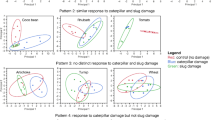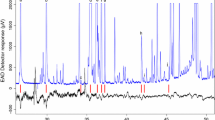Abstract
Chrysothamnus nauseosus (rubber rabbitbrush) is used by browsing animals, especially mule deer (Odocoileus hemionus), as a forage in the winter months. It is used only slightly, if at all in the summer. This dietary difference may result from changes in the secondary chemical composition of the leaves. Solvent extracts from summer and winter rabbitbrush leaves were analyzed by gas chromatography and mass spectrometry, and the volatile compounds were quantified and identified. Hexane and chloroform extracts from winter leaves exhibit a marked concentration decrease in most chemicals when compared to summer extracts. The methanol extracts revealed the presence of several chemicals in the summer leaves that were absent in winter leaves. Rubber rabbitbrush has fewer secondary volatile chemicals in the winter than in the summer. These chemical differences may influence the seasonal dietary difference observed in mule deer and other browsing animals.
Similar content being viewed by others
References
Anderson, L.C. 1986. An overview of the genusChrysothamnus (Asteraceae). pp. 29–45,in E.D. McArthur and B.L. Welch (eds.). Proceedings—Symposium on the Biology ofArtemisia and Chrysothamnus. Provo, Utah, July 9–13, 1984. Intermountain Research Station USDA Forest Service, Gen. Tech. Rep. INT-200. Ogden, Utah.
Bhat, R.B., Weber, D.J., Hegerhorst, D.F., andMcArthur, E.D. 1990a. Rubber and resin content in natural and uniform-garden populations ofChrysothamnus nauseosus subspecies.Phyton 51:35–42.
Bhat, R.B., Welch, B.L., Weber, D.J., andMcArthur, E.D. 1990b. Mid-winter protein, phosphorus, and digestibility ofChrysothamnus nauseosus subspecies.J. Range Manage. 43:177–179.
Bohlmann, F., Dutta, L., Robinson, H., andKing, R. M. 1979. New labdane derivatives fromChrysothamnus nauseosus.Phytochemistry 18:1889–1892.
Deans, S.G., andSvoboda, K.P., 1989. Antibacterial activity of summer savory (Satureja hortensis L.) essential oil and its constituents.J. Hortic. Sci. 64:205–210.
Dowdy, S., andWearden, S. 1983. Statistics for Research. John Wiley & Sons, New York, pp. 194–195.
Hanks, D.L., McArthur, E.D., Plummer, A.P., Giunta, B.C., andBlauer, A.C. 1975. Chromatographic recognition of some palatable and unpalatable subspecies of rubber rabbitbrush in and around Utah.J. Range Manage. 28:144–148.
Harborne, J.B. 1991. Recent advances in the ecological chemistry of plant terpenoids, pp. 297–313,in J.B. Harborne and F.A. Tomas-Barberan (eds.). Proceedings of the Phytochemical Society of Europe, Ecological Chemistry and Biochemistry of Plant Terpenoids. Clarendon Press, Oxford.
Hegerhorst, D.F., Weber, D.J., McArthur, E.D., andKhan, A.J. 1987. Chemical analysis and comparison of subspecies ofChrysothamnus nauseosus and other related species.Biochem. Syst. 15:201–208.
Hegerhorst, D.F., Bhat, R.B., Weber, D.J., andMcArthur, E.D. 1988. Seasonal changes of selected secondary plant products inChrysothamnus nauseosus ssp.turbinatus.Great Basin Nat. 48:1–8.
Hubbell, S.P., Wiemer, D.F., andAdejare, A., 1983. An antifungal terpenoid defends a neotropical tree (Hymenaea) against attack by fungus-growing ants (Atta).Oecologia. 60:321–327.
Maugh, T.H. 1982. Exploring plant resistance to insects.Science 216:722–723.
McArthur, E.D., Blauer, A.C., Plummer, A.P., andStevens, R. 1979. Characteristics and hybridization of important Intermountain shrubs. III. Sunflower family. USDA Forest Service Research Paper INT-200, Intermountain Forest and Range Experiment Station, Ogden, Utah. 82 pp.
Pickett, J.A. 1991. Lower terpenoids as natural insect control agents, pp. 297–313,in J.B. Harborne and F.A. Tomas-Barberan (eds.). Proceedings of the Phytochemical Society of Europe, Ecological Chemistry and Biochemistry of Plant Terpenoids. Clarendon Press, Oxford.
Sampson, A.W., andJesperson, B.S. 1963. California range, brushlands and browse plants.Calif. Agr. Exp. Sta. Serv. Manual, Berkeley. 33:1–162.
Sankhla, N., Davis, T., Weber, D.J., andMcArthur, E.D. 1987. Biology and economic botany ofChrysothamnus (rabbitbrush): A potential useful shrub for arid regions.J. Econ. Taxon. Bot. 10:481–495.
Ward, A.L., 1971.In vitro digestibility of elk winter forage in southern Wyoming.J. Wildl. Manage. 35:681–688.
Weber, D.J., Davis, T.D., McArthur, E.D., andSankhla, N. 1985.Chrysothamnus nauseosus (rubber rabbitbrush): Multiple-use shrub of the desert.Desert Plants 7:172–180, 208–210.
Weber, D.J., Hegerhorst, D.F., Davis, T.D., andMcArthur, E.D. 1987. Potential uses of rubber rabbitbrush (Chrysothamnus nauseosus), pp. 27–33,in K.L. Johnson (ed.). Proceedings of the Fourth Utah Shrub Ecology Workshop: The genusChrysothamnus. Utah State University, Logan.
Author information
Authors and Affiliations
Rights and permissions
About this article
Cite this article
Halls, S.C., Gang, D.R. & Weber, D.J. Seasonal variation in volatile secondary compounds ofChrysothamnus nauseosus (Pallas) britt.; asteraceae ssp.hololeucus (Gray) hall. & clem. Influences herbivory. J Chem Ecol 20, 2055–2063 (1994). https://doi.org/10.1007/BF02066242
Received:
Accepted:
Issue Date:
DOI: https://doi.org/10.1007/BF02066242




